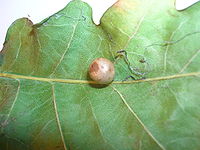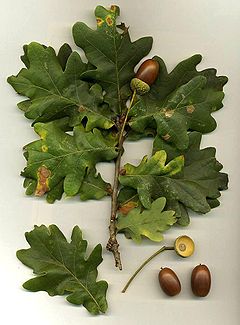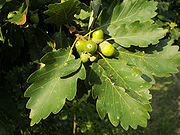
Red-pea gall
Encyclopedia
The Red-pea gall or Red Currant gall develops as a chemically induced distortion arising from the underside of the mid-rib of a vein on Quercus species and it is attached by a short stalk or peduncle. The Red-wart gall is the sexual phase of the same species.
 In appearance it is glossy and somewhat flattened sphere and from ten to fifteen or so may occur on a single leaf. The average size is 5 x 6 mm and the colouring starts as green, passing to yellow, orange and then red-brown; the season is midsummer onwards. Circular emergence holes appear in the galls.
In appearance it is glossy and somewhat flattened sphere and from ten to fifteen or so may occur on a single leaf. The average size is 5 x 6 mm and the colouring starts as green, passing to yellow, orange and then red-brown; the season is midsummer onwards. Circular emergence holes appear in the galls.

 Some herbivorous
Some herbivorous
insects therefore create their own microhabitats by forming, in this case, a highly distinctive plant structure called a gall
, made up of plant tissue, but controlled by the insect. Galls act as both the habitat, and food sources for the maker of the gall. The interior of a bedeguar gall is formed from the bud, and is composed of edible nutritious and structural tissues. Some galls act as "physiologic sinks", concentrating resources in the gall from the surrounding plant parts. Galls may also provide the insect with some physical protection from predators.
Cause
The gall is caused by the parthenogenetic generation of Cynips divisa Hartig, 1840 which has been known by the synonyms Diplolepis divisa, Dryophanta divisa and Spathegaster verrucosus.The physical appearance of the Red-pea gall

Life-cycle
Many of the agamic imagines emerge in October. After over wintering Cynips develops eggs parthenogenetically and their eggs develop in live buds as 'Red-wart galls'. The infested buds become yellow, orange or a russet colour and are about 4 mm long. These Red-wart galls appear in May and the males and females of the bisexual genertation emerge in June and produce the fertilized eggs which undergo development in the Red-pea galls.Gall forming insects


Herbivore
Herbivores are organisms that are anatomically and physiologically adapted to eat plant-based foods. Herbivory is a form of consumption in which an organism principally eats autotrophs such as plants, algae and photosynthesizing bacteria. More generally, organisms that feed on autotrophs in...
insects therefore create their own microhabitats by forming, in this case, a highly distinctive plant structure called a gall
Gall
Galls or cecidia are outgrowths on the surface of lifeforms caused by invasion by other lifeforms, such as parasites or bacterial infection. Plant galls are abnormal outgrowths of plant tissues and can be caused by various parasites, from fungi and bacteria, to insects and mites...
, made up of plant tissue, but controlled by the insect. Galls act as both the habitat, and food sources for the maker of the gall. The interior of a bedeguar gall is formed from the bud, and is composed of edible nutritious and structural tissues. Some galls act as "physiologic sinks", concentrating resources in the gall from the surrounding plant parts. Galls may also provide the insect with some physical protection from predators.
Infestations of Red-pea galls
Removing and destroying Red-pea galls causes more harm than good. While sometimes present in quite large numbers on scrub specimens, they cause no measurable harm.See also
- Knopper gallKnopper gallAndricus quercuscalicis is a gall wasp species inducing Knopper galls.Knopper galls develop as a chemically induced distortion of growing acorns on Pedunculate Oak trees, caused by gall wasps, which lay eggs in buds with their ovipositor...
- Oak marble gallOak marble gallOak marble galls develop as a chemically induced distortion of leaf buds on pedunculate oak , or sessile oak trees, caused by the parthenogenetic gall wasp which lays eggs within leaf buds using their ovipositor...
- oak appleOak appleOak apple is the common name for a large, round, vaguely apple-like gall commonly found on many species of oak. Oak apples range in size from 2-5cm. Oak apples are caused by chemicals injected by the larva of certain kinds of gall wasp in the family Cynipidae. The adult female wasp lays single...
- gallGallGalls or cecidia are outgrowths on the surface of lifeforms caused by invasion by other lifeforms, such as parasites or bacterial infection. Plant galls are abnormal outgrowths of plant tissues and can be caused by various parasites, from fungi and bacteria, to insects and mites...
- Oak artichoke gallOak artichoke gallOak artichoke galls, oak hop galls, larch-cone galls or hop strobiledevelop as a chemically induced distortion of leaf axillary or terminal buds on Pedunculate Oak or Sessile Oak trees, caused by the parthenogenetic gall wasp Andricus fecundator, which lays single eggs within leaf buds using...
- Cola-nut gallCola-nut gallCola-nut galls develop as a chemically induced distortion of leaf axillary or terminal buds on Pedunculate Oak or Sessile Oak trees, caused by the agamic gall wasp Andricus lignicola which lays single eggs within leaf buds using their ovipositor. A previous name or synonym for the species A....

